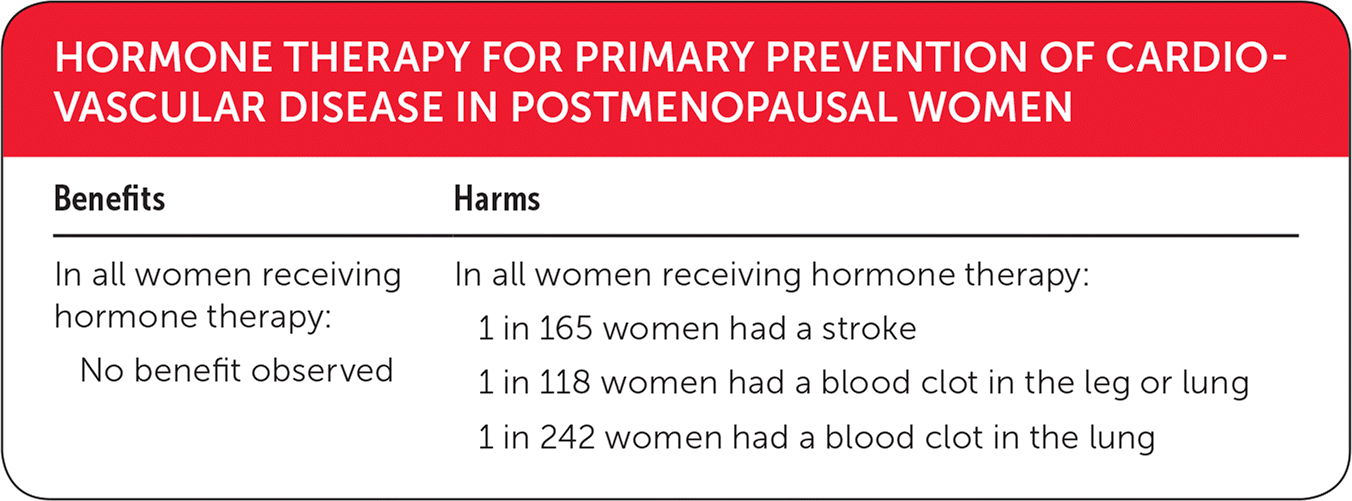
Am Fam Physician. 2018;98(7):online
Author disclosure: No relevant financial affiliations.


| Benefits | Harms |
|---|---|
In all women receiving hormone therapy:
| In all women receiving hormone therapy:
|
Details for This Review
Study Population: 40,410 postmenopausal women (healthy or with preexisting cardiovascular disease) across 19 randomized controlled trials that examined the use of oral hormone therapy (estrogen with or without progesterone taken for at least six months) compared with placebo
Efficacy End Points: Death from any cause; death caused by heart attack; nonfatal heart attack
Harm End Points: Stroke, thromboembolic event (deep venous thrombosis plus pulmonary embolism) or pulmonary embolism
Narrative: In 2012, the Danish Osteoporosis Prevention Study published a study in the British Medical Journal that compared hormone therapy with placebo and found a decreased risk of heart failure, heart attack, and death from any cause.1 They also found no increased risk of cancer, blood clots, or stroke. Although the Danish cohort studied younger women and used different preparations of hormone therapy, the results were in direct contrast to most of the studies analyzed in a 2005 Cochrane review. This 2005 review found no benefit of hormone therapy in preventing cardiovascular disease, but noted significant increases in the risk of developing stroke and blood clots in a leg or lung.2
The 2015 Cochrane review added six additional studies (compared with the initial review published in 20133), for a total of 19 randomized controlled trials, consisting of 40,410 postmenopausal women.4 The studies examined the use of oral hormone therapy (estrogen with or without progesterone) taken for at least six months, compared with placebo, to determine the effect on death from any cause, and death caused by heart attack, nonfatal heart attack, angina, revascularization, stroke, and blood clot in a leg or lung. The current review found no benefits in the primary prevention of heart attack (fatal or nonfatal), angina, revascularization, or death due to any cause. However, they did find increases in the risk of stroke (relative risk [RR] = 1.32; 95% confidence interval [CI], 1.12 to 1.56; absolute risk increase [ARI] = 0.6%; number needed to harm [NNH] = 165), blood clot in a leg or lung (RR = 1.92; 95% CI, 1.24 to 2.99; ARI = 0.8%; NNH = 118), and blood clot in a lung (RR = 1.89; 95% CI, 1.17 to 3.04; ARI = 0.4%; NNH = 242) in patients receiving hormone therapy for at least six months.
Caveats: In response to the Danish study,1 the authors of the Cochrane review performed a subgroup analysis to assess for the possibility that women less than 10 years postmenopause may have a different response than women more than 10 years postmenopause. The current Cochrane analysis revealed that although older women (more than 10 years postmenopause) still have increased risk of stroke (RR = 1.21; 95% CI, 1.06 to 1.38; ARI = 1%; NNH = 102) and blood clot in a leg or lung (RR = 1.96; 95% CI, 1.37 to 2.80; ARI = 1%; NNH = 101), younger women (less than 10 years postmenopause) had some benefit, including lower rates of death (RR = 0.70; 95% CI, 0.52 to 0.95; absolute risk reduction [ARR] = 0.7%; number needed to treat [NNT] = 146) and lower rates of fatal and nonfatal heart attacks (RR = 0.52; 95% CI, 0.29 to 0.96; ARR = 0.7%; NNT = 133). Yet, younger women still had increased risk of blood clot in a leg or lung (RR = 1.74; 95% CI, 1.11 to 2.73; ARI = 0.5%; NNH = 214). This may explain the contradictory results seen in the Danish study, but the findings of this subgroup analysis were derived from only a few studies that involved many fewer patients than the overall review. Consequently, further studies will be required to determine whether there may be some cardiovascular benefit of hormone therapy in younger postmenopausal women.
There are some biases that might have affected the results of the meta-analysis. First, most patients enrolled in the trials were on average older than 60 years at baseline. Given the possibility of time-from-menopause being a possible confounder, this issue could subject the analysis to significant bias. Second, different hormone therapy regimens were used in the trials, introducing heterogeneity in the meta-analysis. The overall quality of evidence, however, is rated as high by the authors of the Cochrane review.4
